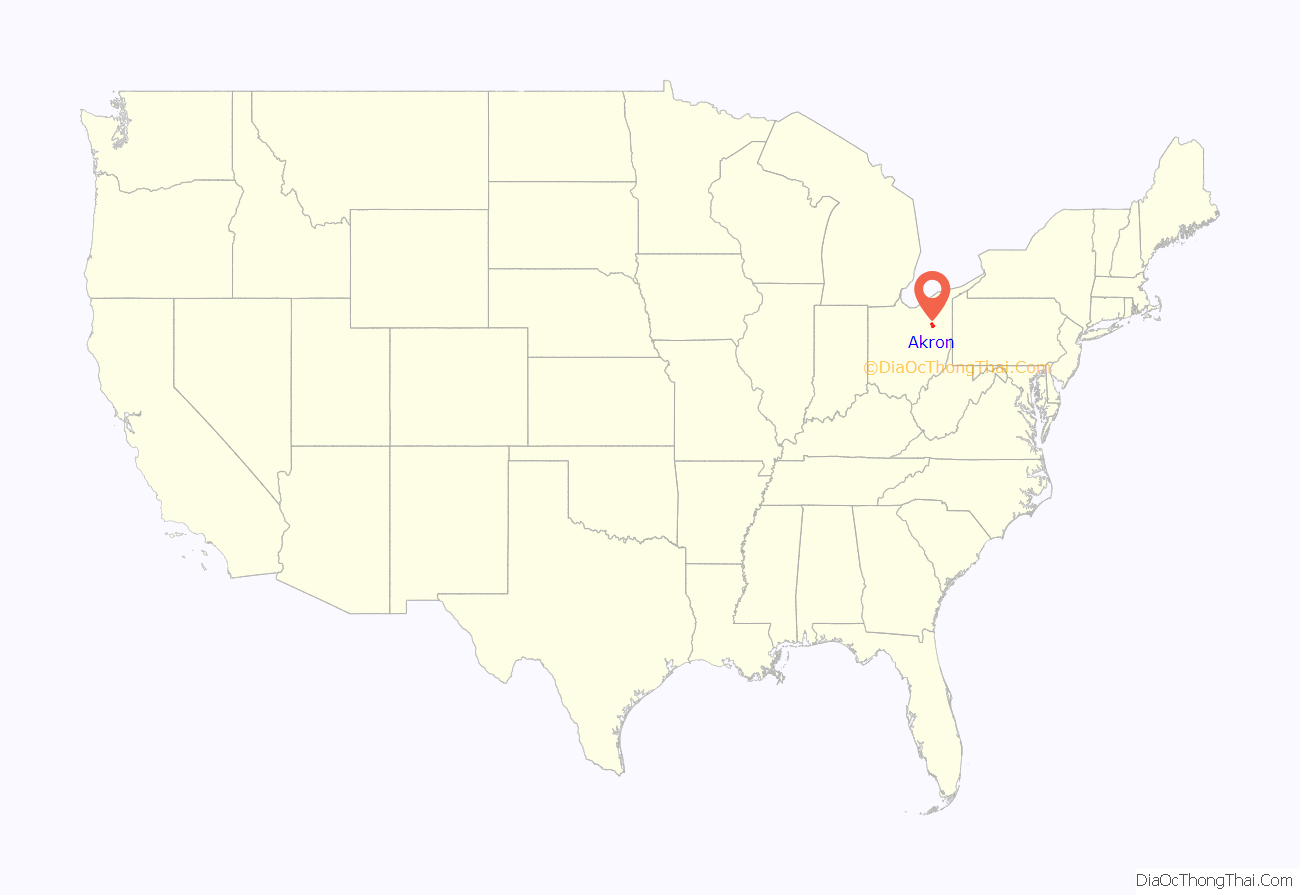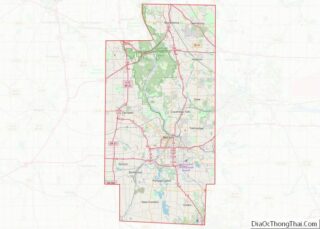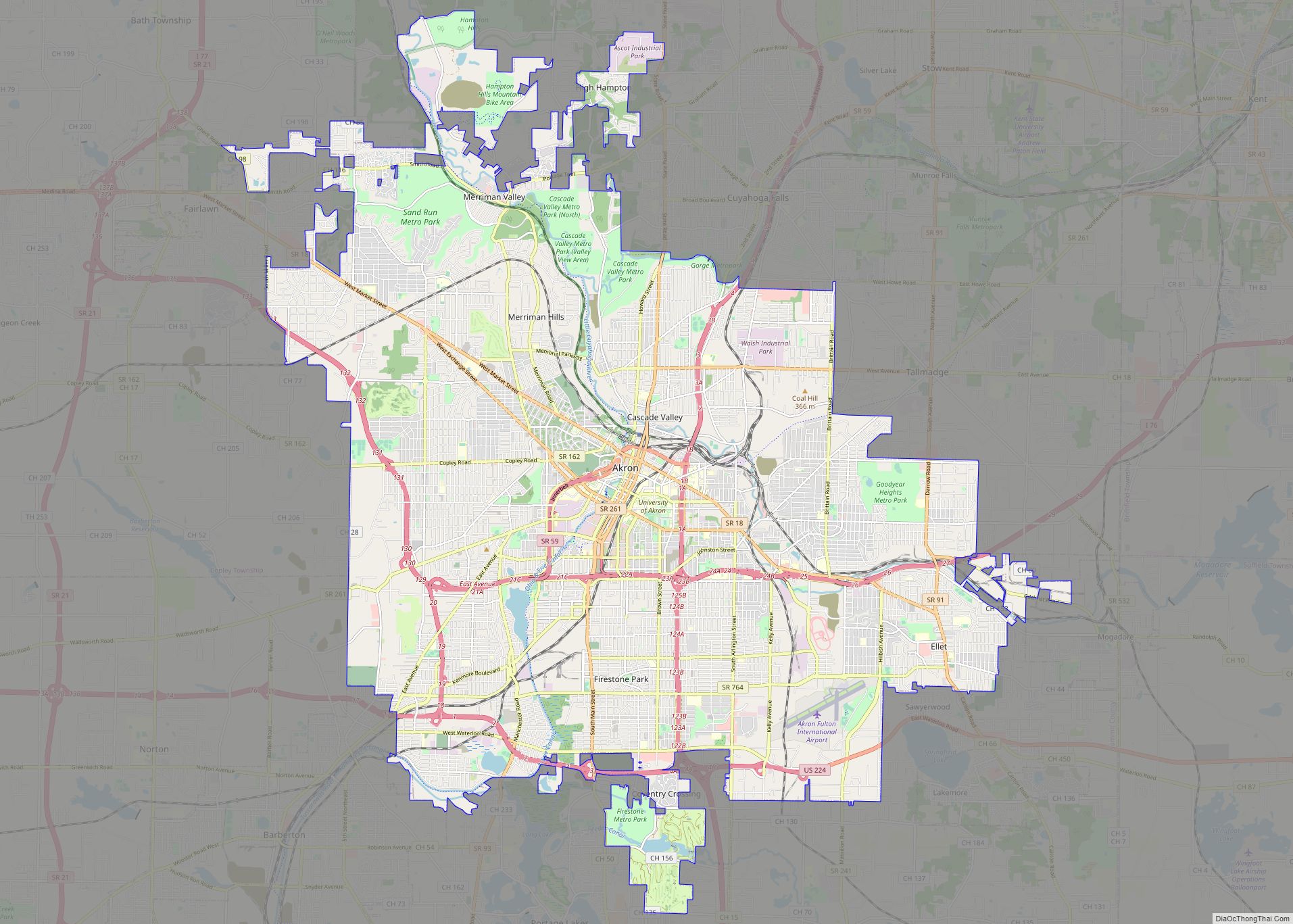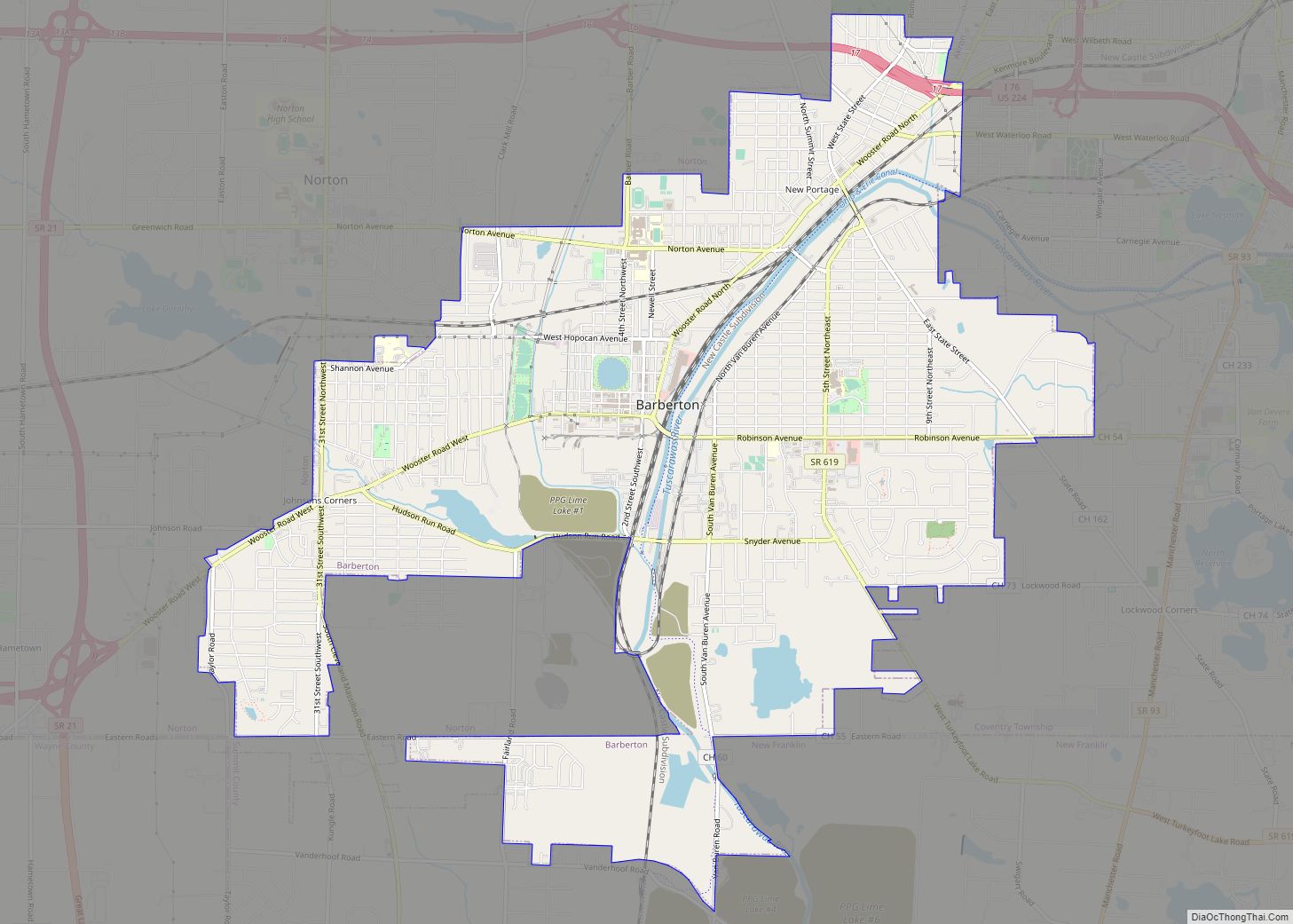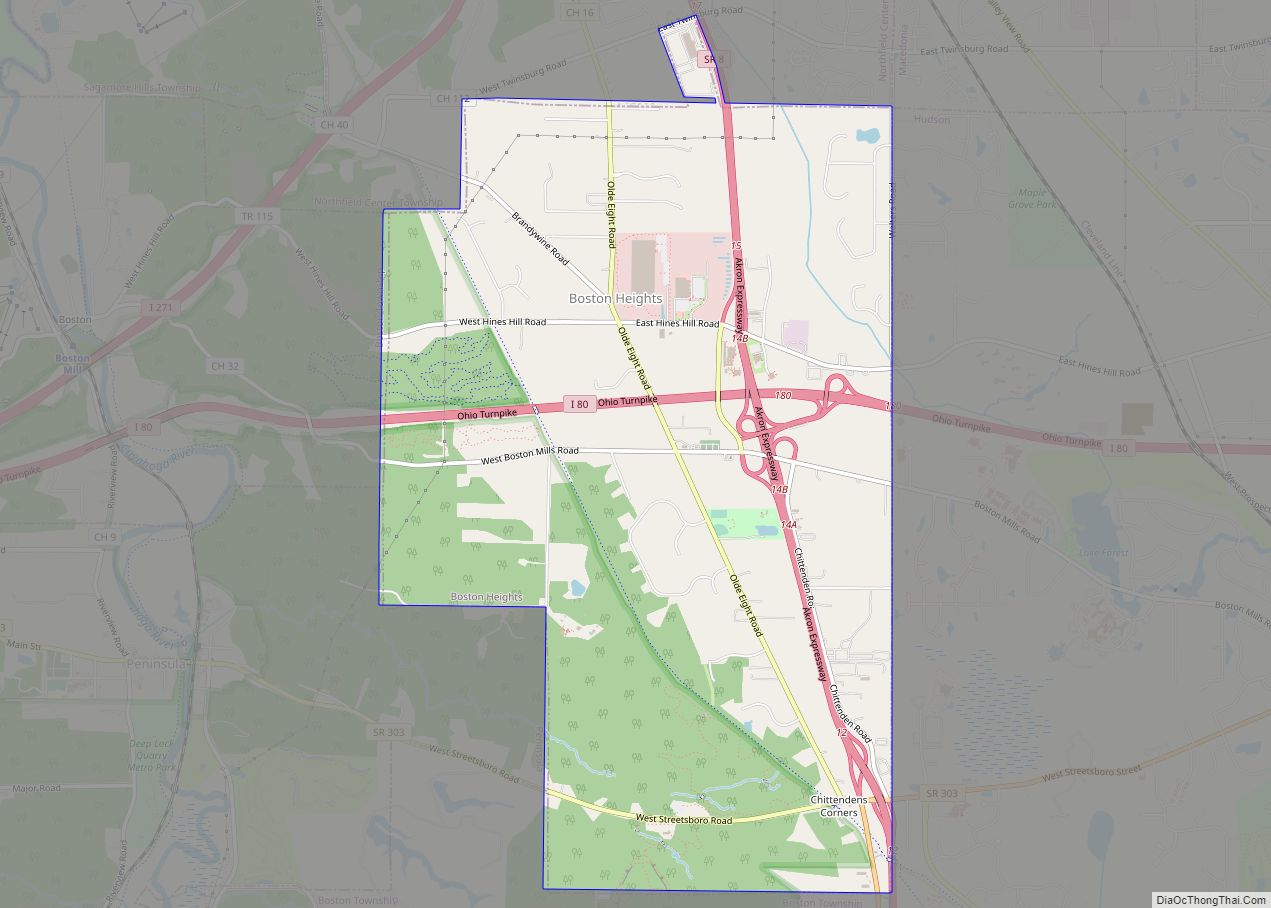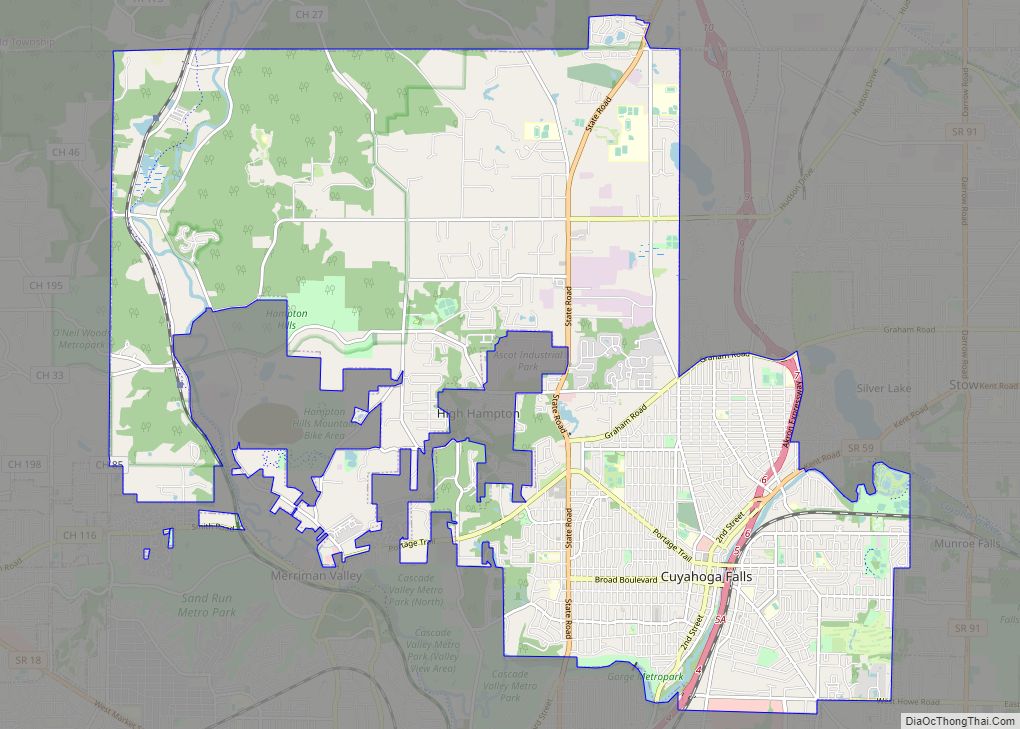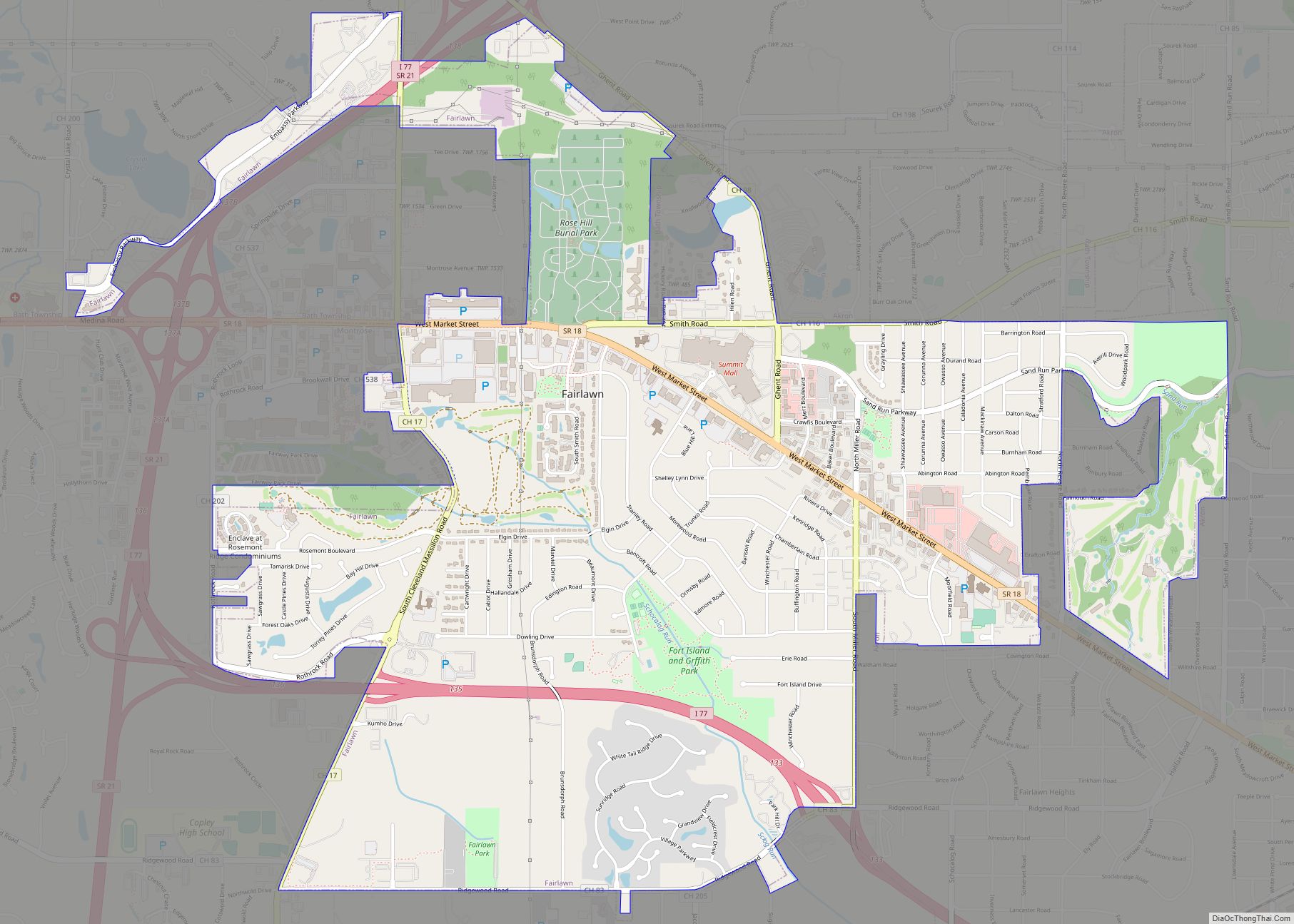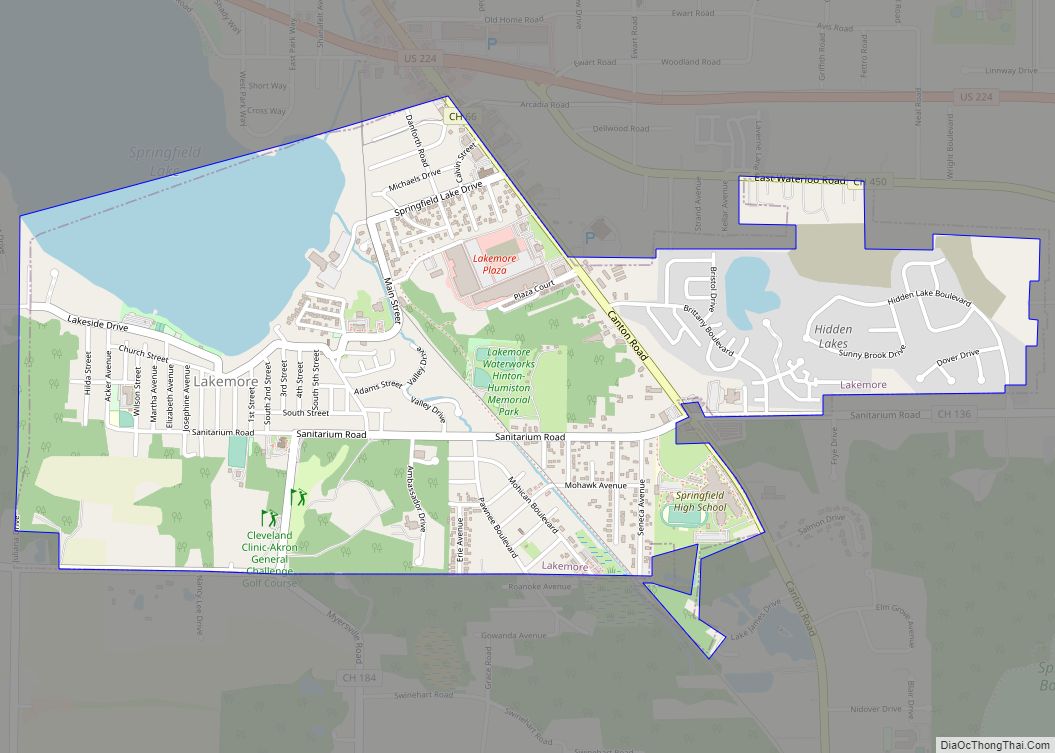Akron (/ˈækrən/) is the fifth-largest city in the U.S. state of Ohio and is the county seat of Summit County. It is located on the western edge of the Glaciated Allegheny Plateau, about 40 miles (64 km) south of downtown Cleveland. At the 2020 census, the city proper had a total population of 190,469, making it the 125th largest city in the United States. The Akron metropolitan area, covering Summit and Portage counties, had an estimated population of 703,505.
The city was founded in 1825 by Simon Perkins and Paul Williams, along the Little Cuyahoga River at the summit of the developing Ohio and Erie Canal. The name is derived from the Ancient Greek word ἄκρον : ákron signifying a summit or high point. It was briefly renamed South Akron after Eliakim Crosby founded nearby North Akron in 1833, until both merged into an incorporated village in 1836. In the 1910s, Akron doubled in population, making it the nation’s fastest-growing city.
A long history of rubber and tire manufacturing, carried on today by The Goodyear Tire & Rubber Company, gave Akron the nickname “Rubber Capital of the World”. It was once known as a center of airship development. Today, its economy includes manufacturing, education, healthcare, and biomedical research; leading corporations include Gojo Industries, FirstEnergy, Huntington Bank, and Charter Spectrum.
Notable historic events in Akron include the passage of the Akron School Law of 1847, which created the K–12 system; the popularization of the church architectural Akron Plan, the foundation of Alcoholics Anonymous, the Akron Experiment into preventing goiters with iodized salt, the 1983 Supreme Court case City of Akron v. Akron Center for Reproductive Health; and portions of the 2014 Gay Games. A racially diverse city, it has seen noted racial relations speeches by Sojourner Truth in 1851—the Ain’t I A Woman? speech; W. E. B. Du Bois in 1920; and President Bill Clinton in 1997. In 1914, Marcus Garvey founded the Universal Negro Improvement Association in Akron. Episodes of major civil unrest in Akron have included the riot of 1900, rubber strike of 1936, and the Wooster Avenue riots of 1968.
| Name: | Akron city |
|---|---|
| LSAD Code: | 25 |
| LSAD Description: | city (suffix) |
| State: | Ohio |
| County: | Summit County |
| Founded: | 1825 |
| Incorporated: | 1836 (village) |
| Elevation: | 1,004 ft (306 m) |
| Land Area: | 61.93 sq mi (160.41 km²) |
| Water Area: | 0.34 sq mi (0.88 km²) 0.55% |
| Population Density: | 3,075.40/sq mi (1,187.42/km²) |
| ZIP code: | 44301-44321, 44325-44326, 44328, 44333-44334, 44372, 44396, 44398 |
| FIPS code: | 3901000 |
| GNISfeature ID: | 1064305 |
| Website: | www.akronohio.gov |
Online Interactive Map
Click on ![]() to view map in "full screen" mode.
to view map in "full screen" mode.
Akron location map. Where is Akron city?
History
In 1811, Paul Williams settled near the corner of what is now Buchtel Avenue and Broadway. He suggested to General Simon Perkins, who was surveyor of the Connecticut Land Company’s Connecticut Western Reserve, that they found a town at the summit of the developing Ohio and Erie Canal. The name is adapted from the Greek word ἄκρον (ákron), meaning summit or high point. It was laid out in December 1825, where the south part of the downtown Akron neighborhood sits today. Irish laborers working on the Ohio Canal built about 100 cabins nearby.
After Eliakim Crosby founded “North Akron” (also known as Cascade) in the northern portion of what is now downtown Akron in 1833, “South” was added to Akron’s name until about three years later, when the two were merged and became an incorporated village in 1836. In 1840, Summit County formed from portions of Portage, Medina, and Stark Counties. Akron replaced Cuyahoga Falls as its county seat a year later and opened a canal connecting to Beaver, Pennsylvania, helping give birth to the stoneware, sewer pipe, fishing tackle, and farming equipment industries. In 1844, abolitionist John Brown moved into the John Brown House across the street from business partner Colonel Simon Perkins, who lived in the Perkins Stone Mansion. The Akron School Law of 1847 founded the city’s public schools and created the K–12 grade school system, which currently is used in every U.S. state. The city’s first school is now a museum on Broadway Street near the corner of Exchange.
1850s–1890s: Summit City
When the Ohio Women’s Rights Convention came to Akron in 1851, Sojourner Truth extemporaneously delivered her speech named “Ain’t I A Woman?”, at the Universalist Old Stone Church. In 1870, a local businessman associated with the church, John R. Buchtel, founded Buchtel College, which became the University of Akron in 1913.
Ferdinand Schumacher bought a mill in 1856, and the following decade mass-produced oat bars for the Union Army during the American Civil War; these continued to sell well after the war. Akron incorporated as a city in 1865. Philanthropist Lewis Miller, Walter Blythe, and architect Jacob Snyder designed the widely used Akron Plan, debuting it on Akron’s First Methodist Episcopal Church in 1872. Numerous Congregational, Baptist, and Presbyterian churches built between the 1870s and World War I use it. In 1883, a local journalist began the modern toy industry by founding the Akron Toy Company. A year later, the first popular toy was mass-produced clay marbles made by Samuel C. Dyke at his shop where Lock 3 Park is now. Other popular inventions include rubber balloons, ducks, dolls, balls, baby buggy bumpers, and little brown jugs. In 1895, the first long-distance electric railway, the Akron, Bedford and Cleveland Railroad, began service. On August 25, 1889, the Boston Daily Globe referred to Akron with the nickname “Summit City”. To help local police, the city deployed the first police car in the U.S. that ran on electricity.
1900s–1990s: Rubber Capital of the World
The Riot of 1900 saw assaults on city officials, two deaths, and the destruction by fire of Columbia Hall and the Downtown Fire Station (now the City Building since 1925). The American trucking industry was birthed through Akron’s Rubber Capital of the World era when the four major tire companies Goodrich Corporation (1869), Goodyear Tire and Rubber Company (1898), Firestone Tire and Rubber Company (1900), and General Tire (1915) were headquartered in the city. The numerous jobs the rubber factories provided for deaf people led to Akron being nicknamed the “Crossroads of the Deaf”. On Easter Sunday 1913, 9.55 inches of rain fell, causing floods that killed five people and destroyed the Ohio and Erie Canal system. From 1916 to 1920, 10,000 schoolgirls took part in the successful Akron Experiment, testing iodized salt to prevent goiter in what was known as the “Goiter Belt”.
Rubber companies responded to housing crunches by building affordable housing for workers. Goodyear’s president, F.A. Seiberling, built the Goodyear Heights neighborhood for employees. Likewise, Harvey S. Firestone built the Firestone Park neighborhood for his employees. During the 1910–1920 decade, Akron became a boomtown, being America’s fastest growing city with a 201.8% increase in population. Of the 208,000 citizens, almost one-third were immigrants (also Clark Gable) and their children from places including Europe and West Virginia. In 1929 and 1931 Goodyear’s subsidiary Goodyear-Zeppelin Company manufactured two airships for the United States Navy, USS Akron (ZRS-4) and USS Macon (ZRS-5). Goodyear built a number of blimps for the Navy during WWII and later for advertising purposes. Akron again grew when Kenmore was annexed by voter approval on November 6, 1928. Found hiding under a bed at one of his hideouts in the city, notorious bank robber Charles Arthur “Pretty Boy” Floyd was arrested under the name “Frank Mitchell” in March 1930. Goodyear became America’s top tire manufacturer after merging with The Kelly-Springfield Tire Company in 1935. Lasting five weeks and consisting of roughly 5,000 strikers including union sympathizers from other factories and neighboring states, the Akron Rubber Strike of 1936 successfully used “sit-down” tactic being organized by the United Rubber Workers. During the 1950s–60s Akron surged as use of the automobile did. The historic Rubber Bowl was used by the National Guard of the United States as a base during the racial Wooster Avenue Riots of 1968. Like many other industries of the Rust Belt, both the tire and rubber industries experienced major decline. By the early 1990s, Goodyear was the last major tire manufacturer based in Akron.
2000s: City of Invention
Despite the number of rubber workers decreasing by roughly half from 2000 to 2007, Akron’s research in polymers gained an international reputation. It now centers the Polymer Valley which consist of 400 polymer-related companies, of which 94 were located in the city itself. Research is focused at the University of Akron, which is home to the Goodyear Polymer Center and the National Polymer Innovation Center, and the College of Polymer Science and Polymer Engineering. Because of its contributions to the Information Age, Newsweek listed Akron fifth of ten high-tech havens in 2001. In 2008 “City of Invention” was added to the seal when the All-America City Award was received for the third time. Some events of the 2014 Gay Games used the city as a venue. In 2013, The Goodyear Tire & Rubber Company opened its new global headquarters on Innovation Way, further cementing the company’s relationship with the city [3].
The city also continues to deal with the effects of air and soil pollution from its industrial past. In the southwestern part of the city, soil was contaminated and noxious PCB-laden fumes were put into the air by an electrical transformer deconstruction operation that existed from the 1930s to the 1960s. Cleanup of the site, designated as a Superfund site by the Environmental Protection Agency, began in 1987 and concluded in 2000. The area remains restricted with regular reviews of the site and its underground aquifer.
Racial history
City founder Simon Perkins negotiated a treaty with Native Americans to establish a mail route from the Connecticut Western Reserve to Detroit in 1807, an early example of historic humanitarian affairs in Akron. Aside from being part of the Underground Railroad, when active, John Brown was a resident, today having two landmarks (the John Brown House and the John Brown Monument) dedicated to him. During the 1851 Women’s Rights Convention, Sojourner Truth delivered her speech entitled “Ain’t I A Woman?”. In 1905, a statue of an Indian named Unk was erected on Portage Path, which was part of the effective western boundary of the White and Native American lands from 1785 to 1805. The Summit County chapter of the Ku Klux Klan reported having 50,000 members, making it the largest local chapter in the country during the 20th century. At some point the sheriff, county officials, mayor of Akron, judges, county commissioners, and most members of Akron’s school board were members. The Klan’s influence in the city’s politics eventually ended after Wendell Willkie arrived and challenged them. Race took part in two of Akron’s major riots, the Riot of 1900 and the Wooster Ave. Riots of 1968. Others giving speeches on race in the city include W. E. B. Du Bois (1920) and President Bill Clinton (1997). In 1971, Alpha Phi Alpha Homes Inc. was founded in Akron by the Eta Tau Lambda chapter, with James R. Williams as chairman. The centerpiece, Henry Arthur Callis Tower, is located in the Channelwood Village area of the city. In 2008, 91-year-old Akron native, Addie Polk, became the poster child of the financial crisis of 2007–2010, after shooting herself.
Akron Road Map
Akron city Satellite Map
Geography
Akron is located in the Great Lakes region about 39 miles (63 km) south of Lake Erie, on the Glaciated Allegheny Plateau. It is bordered by Cuyahoga Falls on the north and Barberton in the southwest. It is the center of the Akron metropolitan area which covers Summit and Portage Counties, and a principal city of the larger Cleveland–Akron–Canton Combined Statistical Area. Located on the western end of the plateau, the topography of Akron includes rolling hills and varied terrain. The Ohio and Erie Canal passes through the city, separating the east from west. Akron has the only biogas facility in the United States that produces methane through the decomposition process of sludge to create electricity. According to the 2010 census, the city has a total area of 62.37 square miles (161.5 km), of which 62.03 square miles (160.7 km) (or 99.45%) is land and 0.34 square miles (0.88 km) (or 0.55%) is water.
Climate
Akron has a humid continental climate (Köppen Dfa), typical of the Midwest, with four distinct seasons, and lies in USDA hardiness zone 6b, degrading to zone 6a in the outlying suburbs. Winters are cold and dry but typically bring a mix of rain, sleet, and snow with occasional heavy snowfall and icing. January is the coldest month with an average mean temperature of 26.1 °F (−3.3 °C), with temperatures on average dropping to or below 0 °F (−18 °C) on 3.8 days and staying at or below freezing on 41 days per year. Snowfall averages 47.5 inches (121 cm) per season, significantly less than the snowbelt areas closer to Lake Erie. The snowiest month on record was 37.5 inches (95 cm) in January 1978, while winter snowfall amounts have ranged from 82.0 in (208 cm) in 1977–78 to 18.2 in (46 cm) in 1949–50. Springs generally see a transition to fewer weather systems that produce heavier rainfall. Summers are typically very warm and humid with temperatures at or above 90 °F (32 °C) on 8.0 days per year on average; the annual count has been as high as 36 days in 1931, while the most recent year to not reach that mark is 2004. July is the warmest month with an average mean temperature of 72.0 °F (22 °C). Autumn is relatively dry with many clear warm days and cool nights.
The all-time record high temperature in Akron of 104 °F (40 °C) was established on August 6, 1918, and the all-time record low temperature of −25 °F (−32 °C) was set on January 19, 1994. The most precipitation to fall on one calendar day was on July 7, 1943, when 5.96″ of rain was measured. The first and last freezes of the season on average fall on October 18 and April 26, respectively, allowing a growing season of 174 days. The normal annual mean temperature is 49.8 °F (9.9 °C). Normal yearly precipitation based on the 30-year average from 1991 to 2020 is 41.57 inches (1,056 mm), falling on an average 158 days. Monthly precipitation has ranged from 12.55 in (319 mm) in July 2003 to 0.20 in (5.1 mm) in September 1960, while for annual precipitation the historical range is 65.70 in (1,669 mm) in 1990 to 23.79 in (604 mm) in 1963.
Neighborhoods
Akron consists of 21 neighborhoods, with an additional three that are unincorporated but recognized within the city. The neighborhoods of the city differ in design largely because of expansions such as town merging, annexation, housing construction in various time periods, and rubber era.
Maple Valley covers the west end of Copley Road, before reaching I-77. Along this strip are several businesses using the name, as well as the Maple Valley Branch of the Akron-Summit County Public Library. Spicertown falls under the blanket of University Park, this term is used frequently to describe the student-centered retail and residential area around East Exchange and Spicer streets, near the University of Akron. West Hill is roughly bounded by West Market Street on the north, West Exchange Street on the south, Downtown on the East, and Rhodes Avenue on the west. It features many stately older homes, particularly in the recently recognized Oakdale Historic District.
Suburbs
Akron’s suburbs include Barberton, Cuyahoga Falls, Fairlawn, Green, Hudson, Mogadore, Montrose-Ghent, Munroe Falls, Norton, Silver Lake, Stow, and Tallmadge. Akron formed Joint Economic Development Districts with Springfield, Coventry, Copley, and Bath (in conjunction with Fairlawn) townships.
See also
Map of Ohio State and its subdivision:- Adams
- Allen
- Ashland
- Ashtabula
- Athens
- Auglaize
- Belmont
- Brown
- Butler
- Carroll
- Champaign
- Clark
- Clermont
- Clinton
- Columbiana
- Coshocton
- Crawford
- Cuyahoga
- Darke
- Defiance
- Delaware
- Erie
- Fairfield
- Fayette
- Franklin
- Fulton
- Gallia
- Geauga
- Greene
- Guernsey
- Hamilton
- Hancock
- Hardin
- Harrison
- Henry
- Highland
- Hocking
- Holmes
- Huron
- Jackson
- Jefferson
- Knox
- Lake
- Lake Erie
- Lawrence
- Licking
- Logan
- Lorain
- Lucas
- Madison
- Mahoning
- Marion
- Medina
- Meigs
- Mercer
- Miami
- Monroe
- Montgomery
- Morgan
- Morrow
- Muskingum
- Noble
- Ottawa
- Paulding
- Perry
- Pickaway
- Pike
- Portage
- Preble
- Putnam
- Richland
- Ross
- Sandusky
- Scioto
- Seneca
- Shelby
- Stark
- Summit
- Trumbull
- Tuscarawas
- Union
- Van Wert
- Vinton
- Warren
- Washington
- Wayne
- Williams
- Wood
- Wyandot
- Alabama
- Alaska
- Arizona
- Arkansas
- California
- Colorado
- Connecticut
- Delaware
- District of Columbia
- Florida
- Georgia
- Hawaii
- Idaho
- Illinois
- Indiana
- Iowa
- Kansas
- Kentucky
- Louisiana
- Maine
- Maryland
- Massachusetts
- Michigan
- Minnesota
- Mississippi
- Missouri
- Montana
- Nebraska
- Nevada
- New Hampshire
- New Jersey
- New Mexico
- New York
- North Carolina
- North Dakota
- Ohio
- Oklahoma
- Oregon
- Pennsylvania
- Rhode Island
- South Carolina
- South Dakota
- Tennessee
- Texas
- Utah
- Vermont
- Virginia
- Washington
- West Virginia
- Wisconsin
- Wyoming
